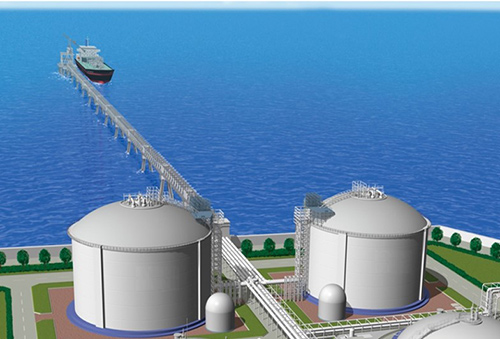IHI Looking to Convert Liquefied Natural Gas Receiving and Storage Terminals into Ammonia-Based Facilities
IHI announced today that it has started looking into converting liquefied natural gas (LNG) receiving and storage terminals (see note 1) near many gas-fired power plants into ammonia-based facilities (see note 2). The company will draw on its corrosion expertise and experimental technologies for materials to study the feasibility of minimally modifying these terminals during the second half of this decade.

Computer-generated image of large ammonia receiving and storage terminal
Interest is increasing in ammonia as a carbon-neutral alternative to coal- and gas-fired power plants because its combustion emissions are free of carbon dioxide. IHI is thus developing technology to use ammonia to fuel boilers and gas turbines. Deploying carbon-neutral fuels entails constructing receiving and storage terminals. Converting LNG facilities should drive ammonia uptake by slashing costs and ensuring effective land usage.
IHI is one of Japan’s leading LNG receiving and storage terminal manufacturers. It has engineered and constructed just under a third of the nation’s LNG receiving and storage terminals and around half of its LNG storage tanks. The company built one of the world’s biggest storage tanks, a 250,000-kiloliter facility. It will leverage the technologies it has amassed in that work in developing new terminals, including storage tanks.
IHI will keep helping to materialize a carbon-neutral economy by developing technologies to use ammonia and building a fuel ammonia supply chain to cater to future demand growth.
Notes
- Receiving and storage terminals handle liquefied fuels shipped within Japan or from abroad, re-gasify them when needed, and pipe them to power plants and other consumption sites.
- Ammonia is a very efficient and affordable energy carrier for hydrogen because it has a high hydrogen density and is easy to handle. Ammonia is also a good direct fuel for thermal power generation. It is a common fertilizer and chemical raw material. Technologies are now in place to integrate everything from ammonia production and transportation through storage. Ammonia is carbon-free, so it could contribute significantly to decarbonizing thermal power operations.
Related news releases
January 18, 2023 – GE and IHI Sign Memorandum of Understanding to Develop Gas Turbines that Can Operate on 100% Ammonia
https://www.ihi.co.jp/en/all_news/2022/resources_energy_environment/1198148_3488.html
January 5, 2023 – Parties Obtain World’s First AiP for Ammonia Floating Storage and Regasification Barge - Contributing to the early introduction of fuel ammonia -
https://www.ihi.co.jp/en/all_news/2022/resources_energy_environment/1198133_3488.html
October 5, 2021 – IHI Starts Developing Large Ammonia Receiving Terminal to Help Establish Large Ammonia Supply Chain
https://www.ihi.co.jp/en/all_news/2021/resources_energy_environment/1197536_3360.html
